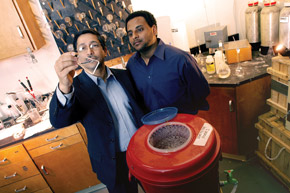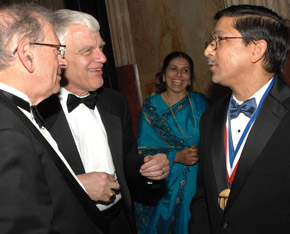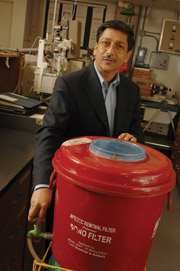Making Drinking Water Safe
Award-winning chemist eliminates arsenic in water one village at a time
By Tara Laskowski, MFA ’06
In the United States, clean drinking water is a luxury most people take for granted. Multimillion-dollar filtration systems and deep wells provide toxin-free water to our homes. But in developing countries, such as Bangladesh, shallow water wells are the norm, and arsenic, a poisonous element, naturally occurs in these wells. In Bangladesh alone, more than 18 million people drink arsenic-contaminated water daily.
Arsenic poisoning is slow and painful and can cause skin cancer, tumors, and ultimately death. People being poisoned with arsenic can have difficulty working or even walking, and continued exposure can lead to liver and kidney failure and the need for amputation of arms or legs.
For Bangladesh native Abul Hussam, associate professor of chemistry and biochemistry at Mason for more than 20 years, the threat of arsenic poisoning hits close to home. About 10 years ago, his brother, a medical doctor in Bangladesh, started to see the frightening consequences of arsenic poisoning in his village. He asked Hussam to help develop a way to measure arsenic levels in wells.
Measuring the Problem
For Hussam, who did his doctoral studies in analytical chemistry at the University of Pittsburgh, developing an instrument to measure arsenic levels in drinking water was a perfect match for his interests.
He began with his own family’s well in Bangladesh. To his shock, he learned that for more than 20 years his family had been drinking water with extremely toxic levels of arsenic. His own father had possibly died from arsenic poisoning.
“Measurement is absolutely critical. It is my strength and what brought me to this project,” says Hussam. “But once you know what you have, then the question becomes, ‘What can we do about it?’”
That’s when Hussam started looking at ways to build a filter to help provide safe drinking water for his family and neighbors. The challenges required looking at such issues as economy, environment, and efficiency. Because Bangladesh is a developing country, the filter had to be inexpensive. Hussam also had to ensure that the materials used were safe for the environment and easy to obtain and reproduce.
After years of research and testing, Hussam developed the Sono Filter. Simple, inexpensive, and made with easily available materials, the filter involves a top bucket, which is filled with locally available coarse river sand that filters coarse particles and imparts mechanical stability and a composite iron matrix that removes inorganic arsenic. In a second bucket, the water is again filtered through coarse river sand, then through wood charcoal to remove organics, and finally through fine river sand and wet brick chips to remove fine particles and stabilize water flow.
A Distinguished Recognition
When Hussam learned the National Academy of Engineering was offering a $1 million Grainger Challenge Award for filtration systems that removed arsenic from drinking water, he knew his work was perfect for the contest. After all, the systems had to be affordable, reliable, easy to maintain, socially acceptable, and environmentally friendly. They had to meet or exceed local government guidelines for arsenic removal and require no electricity—everything he had been working on for years.
In February, Hussam was awarded the Grainger prize at a gala dinner held in Washington, D.C. The $1 million will go to George Mason Intellectual Properties Inc. (GMIP), a separate nonprofit corporation established to facilitate the transfer of new discoveries made at Mason. GMIP will distribute the majority of the award to a Bangladeshi nonprofit organization that will use the funds to increase its production, quality control, and training capacities, so more Sono Filters can reach Bangladeshi households more quickly. Most of the remaining money will fund Hussam’s continuing research in removing toxic cations and anions from drinking water sources. GMIP will keep a small portion of the prize and pay back the Chemistry and Biochemistry Department, which generously funded the tests needed last summer to enable Hussam to enter the contest. GMIP is also handling potentially still patentable matter in the Sono Filter.
Seeing the Difference Firsthand
In 2000, the Hussam family started distributing the Sono Filter in Bangladesh. They started with their own village and donated many of the filters to schools with high arsenic levels in their water.
“At first, the people were not sure whether they should listen to us,” says Hussam. But after talking to them about the water and showing them the filter, which costs only $35 and lasts at least five years, people started to believe.
“Now, we hear of women who want to use the filtered water to shampoo their hair because it makes it softer,” says Hussam, “and people say their tea tastes different and their rice is a different color.” He and his family have also seen hospital patients improve dramatically from arsenic poisoning after drinking filtered water.
Today, more than 30,000 of these filters are used in homes, schools, and businesses in Bangladesh. Hussam hopes that with the prize money they can distribute the filter even more widely and help even more people.

Hussam with chemistry graduate student Kirubel Assegid. The water in the vial was some of the first filtered almost a decade ago, and it is still crystal clear.

President Alan Merten (center) with Hussam at Grainger Award reception

Professor Abul Hussam with his Sono Filter

